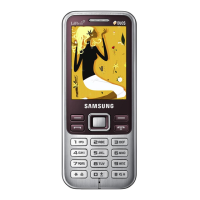
Do you have a question about the Samsung GT-C3322I and is the answer not in the manual?
| Display Type | TFT, 256K colors |
|---|---|
| Display Size | 2.2 inches |
| Resolution | 240 x 320 pixels |
| Main Camera | 2 MP |
| USB | microUSB 2.0 |
| Battery | Removable Li-Ion 1000 mAh battery |
| Status | Discontinued |
| Network | GSM |
| GPRS | Yes |
| EDGE | Yes |
| Phonebook | 1000 entries |
| Call records | Yes |
| Alert types | Vibration, MP3 ringtones |
| Loudspeaker | Yes |
| 3.5mm jack | Yes |
| WLAN | No |
| Messaging | SMS, MMS, Email |
| Browser | WAP 2.0/xHTML |
| Games | Yes |
| SIM | Dual SIM (Mini-SIM) |
| Card Slot | microSD, up to 8 GB |
| 2G bands | GSM 850 / 900 / 1800 / 1900 |
| Radio | Stereo FM radio, RDS |
| Java | Yes |
| Colors | Black |
| Bluetooth | v2.1, A2DP |
Explains symbols like warning, caution, and notes used in the manual.
Details about trademarks and proprietary rights for the device's technologies.
Crucial warnings about potential hazards like injury from small parts or loud sounds.
Precautions regarding equipment installation, battery handling, and interference with medical devices.
Guidance on phone operation, battery care, SIM/memory card handling, and emergency access.
Instructions for checking the contents of the phone package.
Description of the phone's keys and features on the front and rear.
Details the function of each physical key on the phone.
Explains the different areas of the phone's screen display.
Guidance on understanding the icons shown on the phone's display.
Step-by-step guide to insert the SIM card and battery into the phone.
Instructions for charging the phone's battery for the first time.
Procedures for powering the phone on, off, and switching to offline mode.
How to navigate and select options within the phone's menu system.
Adjusting phone settings like volume, ringtones, themes, and menu shortcuts.
Making, answering calls, and using features like speakerphone and headset.
Steps for sending and receiving text, multimedia, and email messages.
Managing phonebook entries, including adding new contacts and searching for existing ones.
Resolving network unavailable errors and poor signal reception.
Troubleshooting issues with dialling, receiving calls, and audio quality.
Addressing battery charging, power-offs, and phone overheating.
Explains RF energy, SAR, FCC limits, and exposure guidelines for wireless phones.
Discusses FDA's role and general information about wireless phone safety.
Guidelines for using the phone in various environments and avoiding interference.
Information on how the phone can affect medical devices, pacemakers, and hearing aids.
Provides practical tips for using the phone safely while driving.
Compliance statement for FCC rules regarding interference.
Warnings about modifications, unauthorized accessories, and handling the device carefully.
Guidelines for phone service, vehicle installation, and airbag safety.
Rules for switching off the phone before boarding aircraft.
Tips for optimizing signal reception and understanding power save features.
Advice on phone care, antenna, receiver, and protection from liquids.
Factors affecting battery life and talk time.
Guidelines for charging, using, and handling batteries safely.
Tips for keeping the phone dry, clean, and preventing damage from mishandling.
Instructions for environmentally safe disposal of the phone and batteries.
Overview of Bluetooth technology and its capabilities.
Steps to enable Bluetooth and make the device discoverable.
Steps to disable the Bluetooth wireless feature.
Guide to searching for and connecting with other Bluetooth devices.
Instructions for transferring files via Bluetooth.
Instructions for receiving files via Bluetooth.
Using the phone with a connected Bluetooth hands-free car kit.
Selecting the USB mode for PC connection and data transfer.